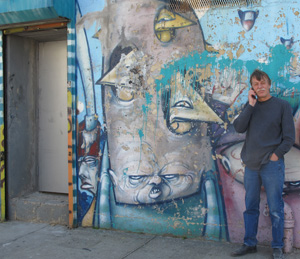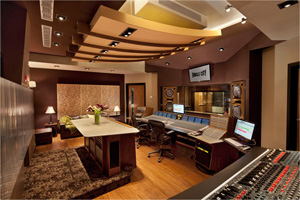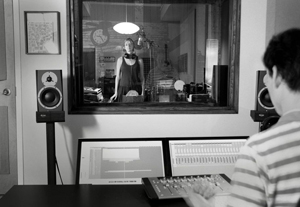Under Construction: An Interview With Studio Builder Chris Harmaty
WILLIAMSBURG, BROOKLYN: Native New Yorker Chris Harmaty has that “seen-it-all” attitude you want in a contractor, whose job tends to involve a lot of complex problem solving. “There are a lot of different ways to make a room work,” Harmaty said at least once during our conversations over coffee at Kellogg’s Diner.
We first met at nearby Converse Rubber Tracks when the facility was still under construction. Harmaty’s company, Audio Structures, had just wrapped up work on Jungle City Studios when they started on Rubber Tracks, along with another major, yet-to-be-announced high-end midtown studio. His candid and open-minded perspective on studio building is like the wisdom that comes with experience – if he hasn’t exactly “seen it all,” he’s sure seen a lot.
Harmaty builds for the best-known studio design firms, including the Walters-Storyk Design Group (WSDG), Pilchner Schoustal and FM Design, as well as for studio owner/designers directly.
For Rubber Tracks, as with Downtown Music – for example – he served as contractor-builder on a team that includes an architect and an acoustic consultant. For Jungle City, Harmaty and crew built out designs by John Storyk and WSDG. And for a more modest build-out, like Let Em’ In Music in Gowanus, he worked directly with owner Nadim Issa to execute the studio plans.
With each project comes new insight into the work, which Harmaty seems to appreciate like both a craftsman and a businessman motivated to hone and refine, to streamline.
“I’m not an acoustician, and I don’t claim to be,” Harmaty says straight up. “But I do know what works and what doesn’t work. And I’ve worked with several different designers who have completely different theories of sound design in a room, and we have happy customers on all fronts.”
Harmaty goes back in this business 25 years. He built his first studio in 1984 – the venerable Studio B at Al Fierstein’s Sorceror Sound, which hosted tons of big sessions over the years, and in its final months, recording sessions for Norah Jones’ Come Away With Me.
“Sorceror was my visual design and Al’s acoustical design,” says Harmaty. “I learned a ton about acoustics on that job and after we finished, Al started recommending me to build other studios. I immediately liked the work – for a contractor, home owners are hard to deal with, where studio owners are business people who’ve usually been through the building process before. So I started doing more and more studios.”
Since then, Harmaty’s had a long run building audio and video production and post-production facilities mostly in the NYC area. The list includes studios for Queen Latifah, R. Kelly, Jim Jones, Alicia Keys, Bang Music, and JYP Entertainment, Blastoff Productions, audio post facilities including audioEngine, Pomann Sound, Dig It Audio, Headroom, Sound Lounge and Northern Lights, and video post houses including Click 3X and Vidiots.
IT’S ALL ABOUT THE DETAILS
Harmaty may have stumbled into his first studio job but when he did, something clicked – the experience harkened back to lifelong interests and a general propensity for making things work. “I’ve been building stuff since I was a kid,” he shares. “I used to build these electronic devices and hide them in my teachers’ desks. And when I was in high school, I built this big psychedelic light show that won the New York State Industrial Arts contest. This was in the late 60s…before there were light shows!
“I can even remember back to when I was in kindergarten, we were weaving potholders and I questioned the weave we were using – my teacher freaked out on me,” he recalls. “I’ve always been the type of guy where I don’t care if somebody’s been doing something a certain way for 100 years, I want to know why they’re doing it that way. If you can’t come up with a good reason, then why should I go along with your program? Maybe I can come up with a better solution!”
Between his aptitude for building and electronics, and the now many years experience building studios, Harmaty has the skill-set and expertise of a rarefied few.
World-class studio architect and acoustician John Storyk, who has been working with Harmaty for years – and currently on a private studio for a high-profile artist in NYC – expounds: “With studio construction, more than any other type of construction I’ve ever seen, it is all about the details. It’s similar only to very high-end residential in the level of execution needed in the construction and accuracy.
“Most of our projects have serious timelines. People need to open on time and there’s not a lot of room for doing things twice. So the knowledge of the details is important. If we’re building in NYC, I don’t have to worry – we just call Chris. At this point he’s seen these details hundreds of times; he knows them by heart.”
And Harmaty has an added specialty even within the audio facilities niche. “Chris is not only a craftsman-style builder, but he’s also specific to NYC, and there’s a whole art to working in NYC,” adds Storyk, who as the designer of Electric Lady, Jazz At Lincoln Center, Jay-Z’s Roc The Mic, and JSM among others, knows a thing or two about building in Manhattan.
“There’s a real, very specific skill-set in dealing with Manhattan studio construction. Chris lives in Manhattan, his guys travel on subways, they know how to get the garbage out, they know how to deal with deliveries, etc. If he doesn’t build a room we’re designing in NYC, it’s because he’s not available.”
WORK FOR HIRE
Harmaty assures that between building some of the highest-profile rooms in the five boroughs, he can also consult with DIY studio owners about to embark on building a new space or new room.
“I can red-flag a situation,” he says. “Before you rent or buy a space where you’re going to build out a studio – call me. Let me walk around the space with you and help you evaluate whether or not the space will work the way you want.”
This is what Nadim Issa, owner of Let Em In Music in Gowanus, initially hired Harmaty to do.
“I made an appointment with Chris to come check out the space with me, prior to renting it. We went through and discussed why it might be good or bad for sound-proofing purposes. And he gave me a rough estimate of what a barebones build-out would cost.”
Later, Issa hired Harmaty to build out his design. “I couldn’t afford to do something extravagant,” he notes.
“But Chris definitely worked with my budget. I knew I wanted to float the live room, though I didn’t know how exactly – there are many ways you can do it and different products you can use. Chris has done a ton of these rooms, and knew which products he wanted to use so I just let him do what he does. He also designed the AC ductwork and laid that all out.”
As more and more producer/engineers and composers consider building out their own rooms and collective facilities, Harmaty’s Audio Structures can be a great first call.
“I can be a source of good advice on how to build your studio – even if you are going to build it yourself,” he notes. “I can also help with costs, and give you ammunition to deal with your subcontractors. Or you can hire me to oversee your subcontractors, come in every couple weeks to supervise
“I can help people on a lower budget to tell them the basics – what they absolutely need to take care of. If you haven’t tested the room, I’ll bring in an acoustic engineer with the proper measuring instruments; it takes a half-an-hour. You may not have the budget to hire a studio architect, but there’s no need to go it totally alone.”
Building his business on referrals all these years, Chris Harmaty never quite got around to setting up a website, though he believes 2011 may be the year! In the meantime, email him with inquiries at chrisharmaty@juno.com.
Please note: When you buy products through links on this page, we may earn an affiliate commission.









